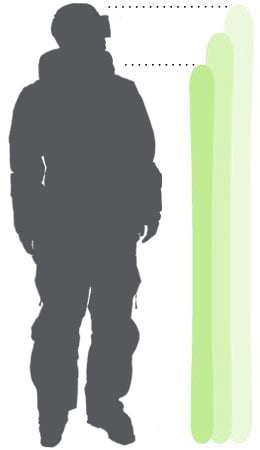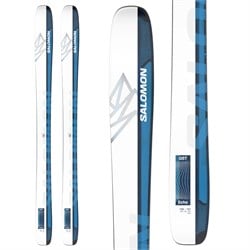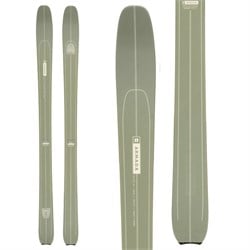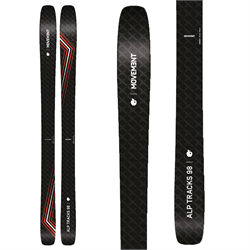How to Choose Alpine Touring, AT, or Backcountry Skis
Building an alpine touring ski setup from scratch can be a daunting process. Between the skis, boots, bindings, skins, and safety gear, there’s a lot to consider. Fortunately, choosing your ski is often the most straightforward, and fun, part! In this guide we’ll take you through the process of picking an alpine touring ski that lines up with your backcountry goals and priorities.
Things to Consider Before Buying an Alpine Touring Ski
At the most basic level, your touring skis can be any pair that you feel comfortable using in the terrain you plan to traverse and ski. For some, it’s as simple as picking their favorite resort ski, mounting a touring binding, and hitting the skin track. While this is perfectly valid, it’s worth weighing up your own priorities and considering the options. Many ski manufacturers now produce touring-specific skis made from lightweight materials that optimize uphill performance, with useful features that make life a little easier as you move through the backcountry.
Before starting out, ask yourself the following questions:
Where and how will I be using this ski?
Do you plan to use this setup for both lift-served skiing and touring? Do you plan short day tours or long, multi-day traverses? Each of these considerations will have an impact on what kind of ski is appropriate. The terrain you wish to travel in will inform the width, shape and weight of your ideal setup.
When will I be using this ski?
Are you heading out in the middle of Winter in search of powder, or going ski mountaineering in Spring and Summer? Time of year can have a significant impact on ski choice. Those touring in late Spring or Summer will usually aim for a lighter, narrower ski.
What kind of skier am I?
Do you ski fast and aggressively all the time, or are you happy to keep it mellow? Are you the one jumping off every cliff in sight, or do prefer to keep your feet planted on the ground? More aggressive skiers may feel limited by the performance characteristics of extremely lightweight skis. Most skiers will want to shoot for a balance of downhill capability and lightweight uphill performance.
What Factors Affect My Choice of Alpine Touring Ski?
Alpine Touring Ski Weights
In the backcountry, it’s up to you to haul your own equipment up the mountain. A heavy ski can easily go unnoticed when riding lifts, but it will quickly become fatiguing as you slog up the skin track. Lighter skis excel on the climb and are easier to handle when performing kick turns. This is a big plus if your tours involve long approaches and technical ascents.
There is, however, a notable trade-off in downhill performance. Heavier touring skis generally do a much better job of handling speed and difficult snow. Extremely lightweight skis can be challenging to control in variable snow, and will typically do a poor job of absorbing vibration and chatter. They can feel ‘pingy’ and easily deflected in snow that heavier skis plow through without a problem.
The answer involves finding the right balance between light weight and solid downhill performance. It’s difficult to know exactly where you lie on the spectrum until you feel things out. Start with what you already know and feel comfortable with, and then get out and tour. You will soon start to get an idea of your own preferences, and find out what compromises work for you. You might hit the right combination straight away, or you may continue to redefine your perfect touring ski for years. Most experienced backcountry skiers take some time to arrive at their ideal compromise between skiability and light weight. Either way you’ll be out there having fun!
Many major ski manufacturers offer touring versions of their popular alpine models using lighter materials like carbon fiber and paulownia wood. Often, they will leave out a layer of metal or some other laminate material to save weight, while adhering as closely as possible to the performance characteristics of the alpine version. This can be a good place to start if you’re not sure where to look.
How to Choose Touring Ski Waist Width
Just like in the resort, the width of your touring ski will have a significant impact on performance and feel. The right width depends on a combination of personal style and your overall objectives in the backcountry.
For ski mountaineering and long spring or summer tours where you’re unlikely to encounter much fresh snow, a waist width of 85mm - 95mm is appropriate. Backcountry skis in this range will generally feel lighter and more nimble than wider skis, making them easier to handle when skinning, and offering greater precision on technical descents.
For mid-winter touring where you expect to ski plenty of deep or variable snow, a waist width in the 100mm - 110mm range will likely feel better. The extra girth comes with an undeniable weight penalty but results in better stability in variable conditions, and superior float in deep snow.
How to Choose Touring Ski Length
Generally speaking, the length of your touring skis should not differ too much from what you typically use at the resort. Some backcountry skiers choose to size down in order to save weight and make the ski feel a little more maneuverable. This makes kick turns easier, and can help navigate tight terrain like steep, narrow couloirs. This is perfectly normal, but it’s worth considering what impact this has on your skiing. It’s no good sizing down for an easier time on the skin track if the turns are no fun! If you find yourself between sizes, erring on the shorter side for your touring ski will usually be a good bet.
| Skier Height in feet & inches | Skier Height in centimeters (cm) | Suggested Ski Lengths (cm) | Shop Skis by Length (cm) |
| 4'4" | 132< | 115-130 | 130-139 |
| 4'6" | 137 | 125-140 | |
| 4'8" | 142 | 130-145 | 140-149 |
| 4'10" | 147 | 135-150 | |
| 5' | 152 | 135-155 | 150-159 |
| 5'2" | 158 | 145-165 | |
| 5'4" | 163 | 150-170 | 160-169 |
| 5'6" | 168 | 155-175 | |
| 5'8" | 173 | 160-180 | 170-179 |
| 5'10" | 178 | 165-185 | |
| 6' | 183 | 170-190 | 180-189 |
| 6'2" | 188 | 175-195 | |
| 6'4" | 193 | 180-200 | >190 |

Touring Ski Rocker Profile and Tail Shape
Getting a touring ski with at least some tip rocker is a huge benefit in fresh and difficult snow, both for skiing and skinning. Meanwhile having some camber underfoot will aid grip and control in firm conditions. Generally speaking, it's a good idea to go for a hybrid profile that features some combination of the two. Tail rocker on the other hand can be a mixed blessing for touring. Touring-specific skis usually have either a very mild and short tail rocker or none at all. While tail rocker can add maneuverability in steep chutes, it can make uphill kick turns more difficult, and is a disadvantage when setting snow anchors.

Last but not least, you’ll want to make sure that whatever climbing skins you have are able to attach securely to your ski. Skins attach to the tip and tail of your ski with clips or hooks. Many touring skis have a built in plastic cap on the tail with a small notch cut out to hold the clip securely and prevent it slipping or dislodging on the ascent. If you go for a ski that has a rounded twin tip style tail, it is worth doing some research and choosing a pair of climbing skins that can attach securely to this shape. Some attachment systems do better than others, and some companies offer twin-tip specific clips that go a long way to making life on the skin track a little easier.
We recommend that backcountry travelers take an AIARE Level One class or equivalent and practice the skills they learn there regularly with their partners. Here are some great resources for avalanche safety education:
— American Institute for Avalanche Research and Education
— American Avalanche Association
— Northwest Weather and Avalanche Center
— Avalanche Canada
You should carry an avalanche beacon, shovel and probe when travelling in avalanche terrain and know how to use them. Backcountry travel requires an acceptance of the risks involved (avalanches are not the only danger) and implies a willingness to take responsibility for educating oneself about these dangers and ways to mitigate them.
Learn More With Our Other Backcountry Guides:
- Backcountry Basics - How to Get Started
- Backcountry Gear - Checklist
- Backcountry Backpacks - How to Choose
- Avalanche Beacons / Transceivers - How to Choose
- Avalanche Shovels - How to Choose
- Avalanche Probes - How to Choose
- Avalanche Airbags - How to Choose
- Alpine Touring Skis - How to Choose
- Alpine Touring Ski Boots - How to Choose
- Alpine Touring Ski Bindings - How to Choose
- Dynafit (Tech) Bindings - Getting Started
- Backcountry Basics - How to Skin
- Climbing Skins - How to Choose
- Climbing Skins - Size Guide
- Climbing Skins - Weight Chart
- Climbing Skins - How to Cut/Trim
- Outerwear & Layers - How to Dress for the Backcountry
- Splitboarding - How to Get Started
Discover Our Favorite Gear:
This is evo. We are a ski, snowboard, wake, skate, bike, surf, camp, and clothing online retailer with physical stores in Seattle, Portland, Denver, Salt Lake City, Whistler, and Snoqualmie Pass. Our goal is to provide you with great information to make both your purchase and upkeep easy.
evo also likes to travel to remote places across the globe in search of world-class powder turns, epic waves, or legendary mountain biking locations through evoTrip Adventure Travel Trips. Or, if you prefer to travel on your own, check out our ski & snowboard resort travel guides and mountain bike trail guides.
Still have questions? Please call our customer care team at 1.866.386.1590 during Customer Care Hours. They can help you find the right setup to fit your needs.








